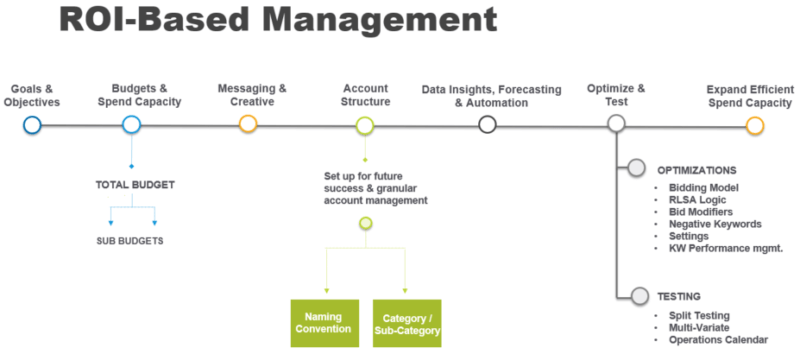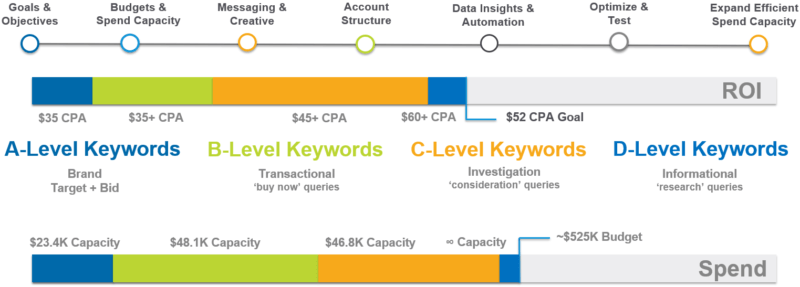Contributor Megan Taggart explains how to incorporate a long-term ROI management approach strategy when inheriting, creating or optimizing a paid search account.

Pay-per-click (PPC) practitioners with mediocre skills simply maintain accounts.
Average practitioners step up the game a little by optimizing accounts.
The truly effective pro, however, has the critical ability to scale and grow search accounts in an organized and calculated manner. Those top performers can increase budgets and maintain a return on investment (ROI) because they have honed strong approaches to account management and optimization. They have established a solid account foundation and are much more apt to drive meaningful value.
Abiding by an ROI-based account management approach when entering or optimizing search accounts yields benefits beyond cost efficiencies. It aids in prioritization, strategic direction, innovation and performance consistency.

This article underscores the value of ROI-based management and how to shift paradigms when approaching search accounts with long-term prosperity in mind.
Setting the table for success
Stepping into an inherited account is the business equivalent of approaching an emergency situation: Triage, speed and intuition are paramount.
Cut off any performance bleed by pausing areas blatantly hindering performance. Next, assess what is working and look to highlight any quick wins or opportunities. This may be a set of keywords, a specific campaign or a combination of tactics.
At this point, communication and clear understanding of goals and objectives are crucial to establish a successful management approach:
- Are stakeholders interested in hitting specific cost-per-action (CPA) goals?
- Are they interested in return on advertising spending (ROAS)?
- Do/will capabilities exist to track back-end performance metrics?
These foundational aspects will define expectations for the search team — what they are responsible for and how to best move forward.
If a 10x ROI goal is assigned to paid search, assessing down-funnel conversion rates allows the team to back into the supplemental top-of-funnel goal metrics and the recommended budget.
Once the team is aligned on goals and objectives, integration will become the overarching focus — integrating front-end data with third-party data sources, as well as the team’s efforts with advanced business intelligence.
Budgets and breakouts
It is common for organizations to have multiple services or products that must be promoted across a variety of search platforms. This is where referencing defined goals alongside performance benchmarks supports budget recommendations.
Doesn’t matter if it’s product-group, service, ROI, CPA or ROAS-focused, once individual goals are set, an overall CPA goal can then be backed into, and budget can be strategically defined and applied in support of end goals. At the end of the day, our goal is to have flexible budgets throughout the portfolio.
Before:

After:

This step also sets the stage for stronger rapport with stakeholders, opening a dialogue about how each product/service group contributes to (or hinders) overall performance goals.
It is also an opportune time to explain the difference between front-end and back-end goals and how, in some cases, we may incur higher CPA costs due to back-end performance.
Maximizing efficient spend capacity
Efficient spend capacity is the amount of budget an account or keyword set can spend given a specific CPA goal. There are many facets of efficient spend capacity, such as what is an affordable CPA goal, the quality of current keyword sets and budget size, as well as seasonality and market trends.
When approaching an account given a finite budget, it is important to identify how and where the budget will go. Prioritizing keywords into groups based on relative CPAs allows for deeper understanding of how each group contributes to hitting the blended or overall target.
For example, if there is a $25,000 monthly budget with a $35 goal CPA, one would look to maximize spend through the keyword groupings providing the lowest CPA/highest ROI that will be labeled as an account’s “A-level” keywords. These A-level keywords are often a mix of brand and the best non-brand terms, and they also tend to be strong target + bid remarketing lists for search ads (RLSA) candidates.
As it is generally impossible to spend the entire budget through this group alone, “B-level” keywords are introduced. This group may have an average CPA above the goal, though the average across all keyword groups will remain below the goal CPA due to the volume generated from brand and A-level keywords. This keyword grouping process continues as we extend into discovery-level or costly keywords to test and exhaust budgets.
It is possible to encounter large influxes of budget, overly aggressive CPA goals or sporadic budget adjustments, and remember that spend and CPA are a diminishing-returns model. As spend continues to rise, CPA will inherently follow until a certain breaking point where performance suffers.
In instances of budget influxes/reductions or aggressive CPA goals, efficient spend capacity can be improved by increasing the amount of budget spent through brand, A-level and B-level keywords. The amount of the budget funneled through those keywords sets the capacity of spend at or under CPA goals.

Efficient spend capacity is a powerful concept in explaining the relationship between budget spend and efficiency in accounts to stakeholders, and at the end of the day, account growth is essentially an increase in efficient spend capacity.
Structuring for long-term success
The term “restructure” when referencing search accounts can lead to unwarranted concern, as it can be interpreted as a complete overhaul in an account. A complete restructure can be a counterproductive approach to increasing efficient spend capacity.
In this case, restructure means setting up an account in a way that allows proper flow of data for true optimization. Ensuring all data is tracked and tagged correctly will create a seamless flow, so it will inform both reporting and optimizations.
There is a fine line in restructuring and creating granularity that hampers statistical significance. Breaking out a campaign so far that it lacks data, either due to data splitting between assets or lack of budget allocation will bring difficulties to optimization and reporting. Set thresholds and decide wat level of granularity works best with given budgets and goals.
Testing and optimization
After goals and structures have been determined, day-to-day efforts should focus on testing and optimization. In the absence of a defined management approach, time can be easily lost in this area. If goals aren’t considered, it’s possible to optimize everything to a goal that’s completely out of alignment.
Even worse, keyword performance indicators (KPIs) could be different from what is being measured, which could completely change the account.
Expansion
Expanding and scaling an account is the last and most important goal of a management approach. As outlined above, this ultimately comes from expanding efficient spend capacity, which increases via new keywords and targeting types.
New keywords and targeting are only part of the battle. Having a proper account structure and setup to give a true flow of data will create opportunities for continuous, quality optimizations, and tests will make keyword and target testing more successful.
Conclusion
Scale will not happen overnight. It takes time, iterative testing, work and strategy. Developing a strong management approach will set an account up for growth and success — not just for the next few months, but for the life of the account.
[Article on Search Engine Land.]
Opinions expressed in this article are those of the guest author and not necessarily Marketing Land. Staff authors are listed here.
Marketing Land – Internet Marketing News, Strategies & Tips
(60)








